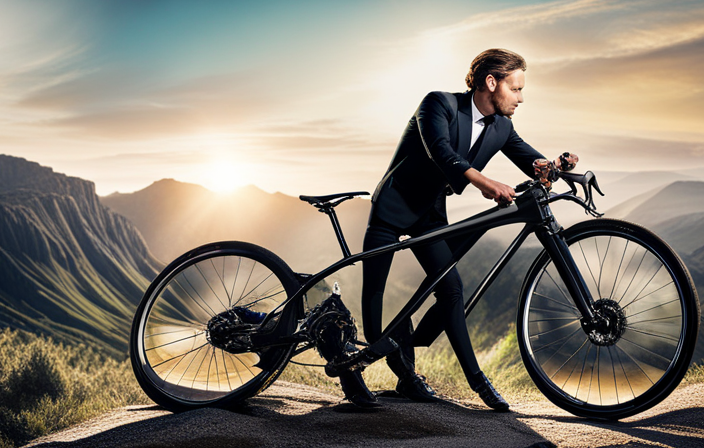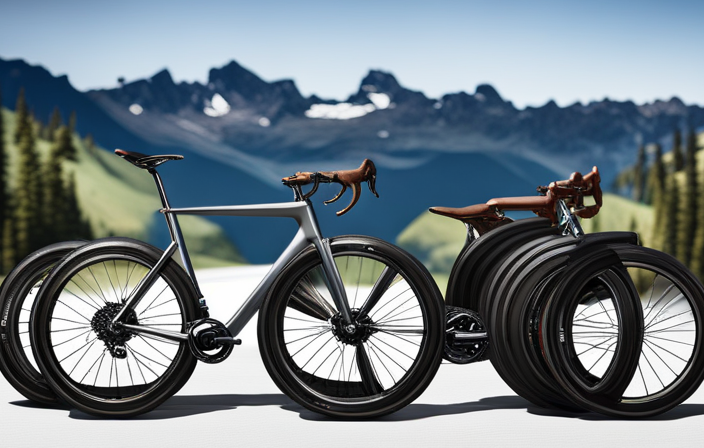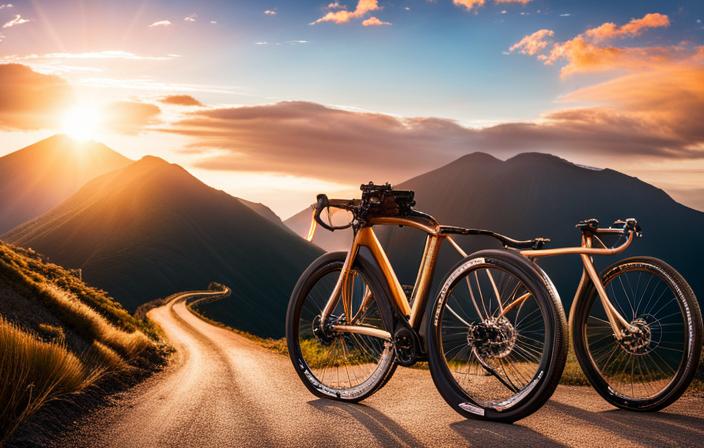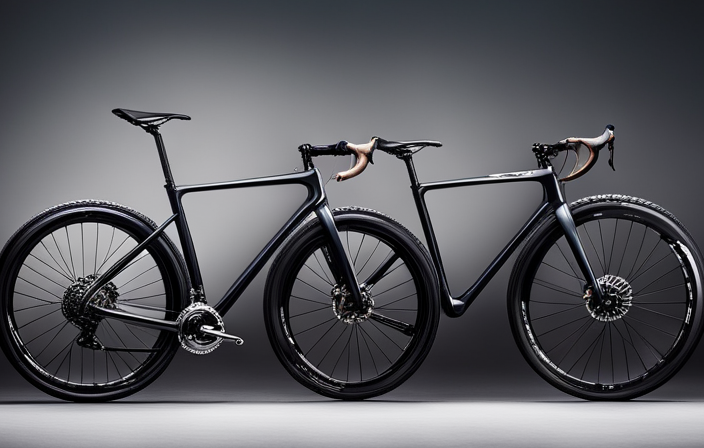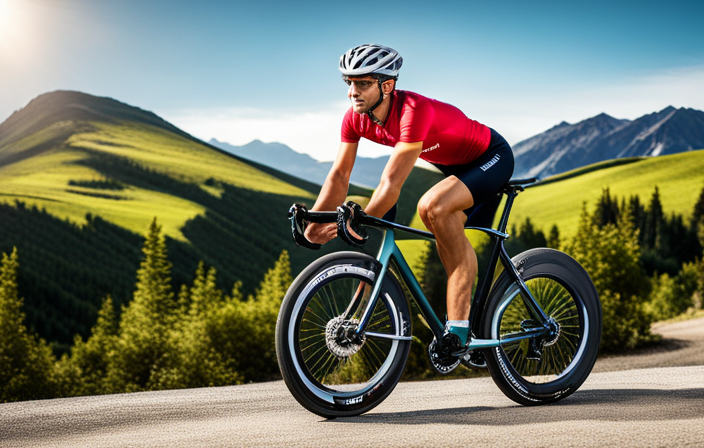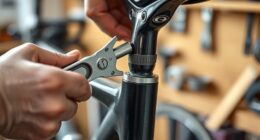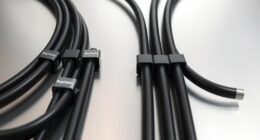Configuring a gravel bike may seem like a challenging endeavor, but worry not! In this guide, I’m going to guide you through the crucial steps to make sure your bike is impeccably adjusted for your gravel explorations.
From choosing the right frame size to adjusting saddle height and handlebar position, we’ll cover it all.
With precise technical knowledge and attention to detail, you’ll have your gravel bike set up like a pro in no time.
So let’s dive in and get ready to conquer the trails with confidence!
Key Takeaways
- Choosing the right bike frame size is crucial for a proper gravel bike setup.
- Adjusting the saddle height and fore-aft position is important for comfort and performance.
- Personalizing the gravel bike through handlebar tape selection can enhance comfort during long rides.
- Ensuring safety by following safety precautions and practicing proper braking technique.
Choosing the Right Bike Frame Size
To choose the right bike frame size, you’ll need to consider your height and inseam measurements. These two factors play a crucial role in ensuring a comfortable and efficient riding experience.
When it comes to gravel bikes, there are various frame materials to choose from, such as aluminum, steel, carbon fiber, or titanium. Each material has its own unique properties in terms of weight, stiffness, and durability.
Additionally, bike frame geometry also plays a significant role in determining the overall fit and handling characteristics of the bike. Factors like stack height, reach length, and head tube angle can greatly affect your riding position and comfort on different terrains.
When considering the right bike frame size for gravel biking, it’s important to take into account not only your current measurements but also any future adjustments you may want to make. Remember that gravel biking often involves long hours in the saddle over rough terrain, so getting the correct fit is crucial for both performance and comfort.
With that being said, once you have chosen the appropriate frame size for your body measurements and considered factors like bike frame material and geometry, you can move onto adjusting the saddle height for optimal pedaling efficiency without sacrificing comfort.
Adjusting the Saddle Height
Start by making sure your saddle height is adjusted correctly. Proper saddle positioning is crucial for comfort and efficiency while riding your gravel bike. To achieve the optimal position, start by placing your heels on the pedals and ensuring that your legs are fully extended without locking out your knees. A simple way to measure this is to have someone assist you in holding a plumb line from just below your kneecap to the center of the pedal axle. Adjust the saddle height until the line aligns with the pedal axle.
In addition to adjusting the height, finding the right saddle width is equally important. Everyone has different sit bone widths, so it’s essential to choose a saddle that matches yours. This can be determined by measuring the distance between your sit bones or using specialized tools available at bike shops.
To further enhance your cycling experience, setting the handlebar position comes next. By transitioning smoothly into this step, you’ll ensure an overall comfortable and efficient riding posture on your gravel bike.
Now let’s move on to setting up the handlebar position for optimal control and stability during rides.
Setting the Handlebar Position
Make sure you find the right handlebar position to maximize control and stability while riding your gravel bike. The handlebars play a crucial role in determining your bike fit, so it’s important to get it right. Here are three key points to consider when setting the handlebar position:
-
Reach: Adjust the distance between the saddle and handlebars to find a comfortable reach. This will ensure that you can easily reach the brakes and shifters without straining your back or shoulders.
-
Drop: The drop refers to the vertical distance between the top of the saddle and the top of the handlebars. A lower drop provides a more aerodynamic position, ideal for speed on flat roads, while a higher drop offers better maneuverability on technical terrain.
-
Handlebar tape options: Choose handlebar tape that provides adequate grip and cushioning for long rides on rough surfaces. Consider options like gel or cork tape for enhanced comfort and vibration absorption.
Finding the perfect handlebar position is crucial for enjoying a smooth ride on your gravel bike. Once you have set up your handlebars correctly, you can move onto installing the right tires for optimal traction and performance.
Installing the Right Tires
Once you have found the perfect handlebar position, it’s time to ensure optimal traction and performance by installing the right tires on your gravel bike.
Choosing tubeless tires is a popular option among gravel cyclists due to their ability to provide a smoother ride and lower risk of punctures. Tubeless tires eliminate the need for inner tubes, which reduces rolling resistance and allows for lower tire pressures. This translates into improved grip on loose surfaces and better shock absorption on rough terrain.
In addition to selecting tubeless tires, it’s crucial to consider sidewall protection. Gravel riding often exposes tires to sharp rocks, thorns, and other hazards that can cause tire damage. To minimize the risk of flats, look for tires with reinforced sidewalls or added puncture protection technologies such as Kevlar or nylon layers. These features enhance durability while maintaining flexibility for a comfortable ride.
Determining the ideal tire pressure will be discussed in the subsequent section about optimizing your bike’s performance. By installing the right tires with appropriate sidewall protection, you’ve taken an important step towards ensuring an enjoyable gravel riding experience.
Determining the Ideal Tire Pressure
To determine the ideal tire pressure, you’ll need to consider factors such as your weight, riding style, and terrain conditions. Determining the recommended tire pressure is crucial for achieving optimal performance on your gravel bike. Understanding the impact of tire pressure on performance will help you make informed choices.
Firstly, your weight plays a significant role in determining tire pressure. Heavier riders generally require higher pressures to prevent pinch flats and reduce rolling resistance. On the other hand, lighter riders may benefit from lower pressures for improved traction and comfort.
Next, consider your riding style. If you prefer a more aggressive approach with faster speeds and aggressive cornering, higher tire pressures can provide better responsiveness and stability. Conversely, if you enjoy a more leisurely ride or prioritize comfort over speed, lower pressures can enhance grip and absorb vibrations.
Terrain conditions also influence the ideal tire pressure. For rougher terrains with loose gravel or uneven surfaces, slightly lower pressures can increase traction and control. On smoother surfaces or pavement sections, higher pressures may be preferred for reduced rolling resistance.
By taking into account these factors—weight, riding style, and terrain conditions—you can determine the ideal tire pressure that suits your specific needs on a gravel bike.
Now let’s move on to checking and adjusting the brake system to ensure maximum safety while riding without compromising performance.
Checking and Adjusting the Brake System
Now, you should check and adjust your brake system to ensure maximum safety while riding. Start by checking the brake pads for wear. If they are worn down, it’s time to replace them. To do this, you’ll need to remove the wheel and locate the brake caliper. Use a 5mm Allen wrench to loosen the bolt that holds the brake pad in place. Slide out the old pad and slide in the new one, making sure it aligns properly with the rim.
Next, you may need to bleed your brakes if they feel spongy or don’t engage smoothly. Bleeding removes any air bubbles from the brake lines, ensuring consistent braking power. To bleed your brakes, you’ll need a bleed kit specific to your brake model and manufacturer instructions.
Follow these steps carefully and be sure to have plenty of clean rags on hand as brake fluid can be messy. Once you’ve completed bleeding your brakes, test them by squeezing the levers firmly. They should engage smoothly without any resistance or excessive play.
With your brakes in top shape, it’s time to move on to installing a proper gear ratio for optimal performance on gravel terrain.
Installing a Proper Gear Ratio
After ensuring that the brake system is in top shape, it’s time to move on to another crucial aspect of setting up your gravel bike: installing a proper gear ratio.
Choosing the appropriate gear ratio is essential for achieving optimal performance and efficiency while riding off-road. Proper gear selection for gravel biking involves finding the right balance between speed and power, allowing you to conquer various terrains with ease.
A well-chosen gear ratio will enable you to maintain a steady cadence regardless of whether you’re climbing steep hills or cruising along flat stretches. To determine the ideal gear ratio for your gravel bike, factors such as terrain, rider strength, and personal preferences need to be considered.
Generally, a lower gear range with smaller front chainrings and larger rear cogs is favored for tackling challenging climbs, while a higher gear range with larger front chainrings and smaller rear cogs allows for faster speeds on flatter sections.
Once you’ve selected the appropriate gear ratio for your needs, you’ll be ready to hit the trails with confidence. Now that we have covered this crucial step in setting up your gravel bike, let’s move on to adding accessories for storage and convenience.
Adding Accessories for Storage and Convenience
Take a look at some practical accessories that will enhance your storage options and make your ride more convenient. When it comes to bikepacking essentials, choosing the right bike bags is crucial. These bags are specifically designed to withstand the demands of off-road riding and provide ample space for all your gear.
A must-have accessory is a frame bag, which attaches to the inside of your bike’s main triangle, providing a low center of gravity for better handling. It’s perfect for storing tools, spare parts, and snacks. Additionally, consider investing in a handlebar bag that offers quick access to items like maps or a camera. Saddlebags are also great for carrying larger items such as sleeping bags or tents.
Other useful accessories include top tube bags, which are ideal for storing small items like energy gels or keys within easy reach while riding. Furthermore, don’t forget about water bottle cages and hydration packs for staying hydrated during long rides.
By adding these accessories to your gravel bike setup, you’ll have all the necessary storage options required for bikepacking adventures while keeping everything within reach and organized.
Now let’s transition into adjusting the suspension (if applicable) to further improve your ride quality.
Adjusting the Suspension (if applicable)
After adding accessories for storage and convenience to my gravel bike, it’s time to focus on adjusting the suspension. This step is crucial if your gravel bike comes equipped with suspension forks or a rear shock. Properly adjusted suspension can greatly improve your comfort and control while riding off-road or on rough terrain.
First, I’ll start by adjusting the fork. Most modern suspension forks have adjustable air pressure and rebound damping settings. Adjusting the air pressure allows you to set the fork’s sag, which determines how much travel is used when you’re sitting on the bike. The rebound damping controls how quickly the fork returns after compressing.
Next, I’ll move onto rear shock maintenance. Similar to the front fork, rear shocks also have adjustable air pressure and rebound damping settings. It’s important to check and adjust these settings regularly to ensure optimal performance.
To help you understand these adjustments better, here’s a table summarizing the key factors for both front forks and rear shocks:
| Suspension Component | Adjustable Settings | Purpose |
|---|---|---|
| Fork Air Pressure | Sag | Determines travel when seated |
| Fork Rebound Damping | Controls speed of fork returning | Enhances control over rough terrain |
| Rear Shock Air | Sag | Determines travel when seated |
| Rear Shock Rebound | Controls speed of shock returning | Improves stability and traction |
With my suspension properly adjusted, I’m now ready to move on to lubricating the chain and other moving parts in order to keep my gravel bike running smoothly.
Lubricating the Chain and Other Moving Parts
To ensure smooth operation and prevent excess wear, make sure you regularly lubricate the chain and other moving parts of your gravel bike. Chain maintenance is essential for optimal performance and longevity of your bike. A well-lubricated chain reduces friction, minimizes noise, and improves shifting accuracy.
Before applying any lubricant, it’s crucial to clean the chain thoroughly. Start by removing any dirt or debris using a brush or a rag. You can also use a degreaser to dissolve stubborn grime. Once the chain is clean, apply a suitable lubricant specifically designed for bicycles. Apply the lube evenly along the entire length of the chain while rotating the pedals backward to ensure complete coverage.
When selecting a lubricant, consider factors such as weather conditions and riding environment. Wet conditions require a heavier oil-based lubricant that provides better protection against moisture, while dry conditions call for lighter lubes that don’t attract as much dirt.
Regularly cleaning and lubricating your bike’s chain will help prolong its lifespan and maintain optimal performance.
Ensuring proper wheel alignment is crucial in achieving a smooth ride experience without any unnecessary strain on components or loss of power transmission caused by misaligned wheels.
Ensuring Proper Wheel Alignment
Make sure you regularly check and adjust your bike’s wheel alignment to ensure a smooth and efficient ride. Proper wheel alignment is essential for optimal performance and preventing unnecessary wear on your gravel bike.
Here are some important wheel alignment techniques to keep in mind:
-
Use a wheel alignment tool: Invest in a quality wheel alignment tool to accurately measure the alignment of your wheels. This will help you identify any misalignments and make necessary adjustments.
-
Check for even tire wear: Uneven tire wear can be an indicator of improper wheel alignment. Inspect the tires regularly to ensure they are wearing evenly across the tread.
-
Use axle spacers: Axle spacers can be used to fine-tune the wheel position within the frame or fork dropouts. They allow you to adjust the spacing between the hub locknuts, ensuring proper alignment.
-
Troubleshoot issues promptly: If you notice any handling issues or vibrations while riding, it could be due to misaligned wheels. Address these issues promptly by checking and adjusting the wheel alignment as needed.
By following these wheel alignment techniques and troubleshooting any potential issues, you can maintain optimal performance and extend the lifespan of your gravel bike.
Now let’s move on to testing the bike for comfort and handling, which is crucial for an enjoyable riding experience without compromising safety.
Testing the Bike for Comfort and Handling
To ensure a comfortable and enjoyable riding experience, test the bike for comfort and handling by adjusting the seat height, checking the suspension, and trying out different handlebar positions. It is important to evaluate bike stability and responsiveness during this process.
One way to assess bike stability is by testing its ability to maintain balance at various speeds. Start with slow speeds and gradually increase as you feel more confident. Pay attention to any wobbling or difficulty in maintaining control. Additionally, try riding over uneven terrain or gravel roads to see how well the bike handles bumps and vibrations.
Another aspect to consider is evaluating bike responsiveness. This can be done by testing how quickly the bike responds to your input when you turn the handlebars or shift your weight. A responsive bike should react smoothly and predictably without any delay or hesitation.
By conducting these tests, you can determine if any adjustments are needed to improve comfort and handling. Once you have completed this evaluation, you can move on to making additional adjustments for personal preference such as saddle position or adding accessories like a bell or lights.
Incorporating these steps will ensure that your gravel bike is set up properly for a comfortable ride that meets your specific needs and preferences.
Making Additional Adjustments for Personal Preference
Once you have completed the evaluation, you can further customize your ride by adjusting the position of the saddle or adding accessories like a bell or lights. Fine-tuning the pedal position is crucial for optimal performance and comfort. It’s important to ensure that your feet are properly aligned with the pedals to prevent any discomfort or potential injury.
Adjusting the saddle height and fore-aft position can also greatly impact your riding experience. Finding the right handlebar tape is another aspect of personalizing your gravel bike. The handlebar tape not only provides grip, but it also absorbs vibrations, enhancing overall comfort during long rides. There are various types of handlebar tapes available, ranging from thick and cushioned to thin and lightweight options, so choose one that suits your preferences.
Transitioning into regular maintenance and care tips, taking these additional adjustments into consideration will create a more personalized ride tailored to your specific needs. However, setting up your gravel bike doesn’t stop at fine-tuning pedal positions and selecting handlebar tape; regular maintenance is essential for keeping your bike in top condition.
Regular Maintenance and Care Tips
Regular maintenance and care tips are crucial for ensuring your gravel bike stays in top condition. To keep your bike running smoothly, it’s important to establish a regular maintenance routine. One of the first things you should do is clean your bike after each ride. This involves washing off any dirt or mud, lubricating the chain, and checking for any loose or damaged parts.
In addition to regular cleaning, it’s important to perform basic maintenance tasks such as checking tire pressure and inspecting the brake pads for wear. Tire pressure affects the bike’s performance and handling, so make sure to inflate them to the recommended PSI. Brake pads should be replaced if they are worn down to avoid compromising safety.
Another essential care tip is to regularly inspect and tighten all bolts on your bike. Vibration from riding can loosen bolts over time, which could lead to components becoming loose or falling off during a ride.
By following these regular maintenance and care tips, you can ensure that your gravel bike remains in optimal condition for every ride.
Transitioning into the subsequent section about safety precautions and riding techniques for gravel biking, it’s important to remember that proper maintenance plays a vital role in maintaining a safe and enjoyable biking experience without any unexpected setbacks or issues arising along the way.
Safety Precautions and Riding Techniques for Gravel Biking
Now that we’ve covered regular maintenance and care tips for your gravel bike, let’s shift our focus to safety precautions and riding techniques. As an avid gravel biker, I have learned the importance of being prepared and aware while out on the trails.
When it comes to navigating steep descents, there are a few key techniques to keep in mind. First, make sure you have proper braking technique down pat – apply even pressure to both brakes and avoid locking up your wheels. Additionally, shift your weight back on the bike to maintain control and stability. It’s also crucial to choose the right line when descending – look ahead for any obstacles or loose gravel that may affect your trajectory.
Safety is paramount when riding in different weather conditions as well. In wet or muddy conditions, reduce your speed and be cautious of slippery surfaces. Maintain a firm grip on the handlebars and use wider tires with lower tire pressures for added traction. When riding in extreme heat or cold, ensure you stay hydrated and dress appropriately for the weather.
To summarize, mastering riding techniques for navigating steep descents and adhering to safety tips for different weather conditions will greatly enhance your gravel biking experience. Stay safe out there!
Frequently Asked Questions
How do I choose the right pedals for my gravel bike?
When choosing pedals for your gravel bike, it’s important to consider pedal types and pedal cleat compatibility.
There are various options available, such as flat pedals, clipless pedals, or hybrid pedals that offer both options.
Flat pedals provide a more casual riding experience and are compatible with any type of shoe.
On the other hand, clipless pedals allow for efficient power transfer and require cycling-specific shoes with compatible cleats.
Make sure to choose a pedal type that suits your riding style and preferences.
What kind of clothing and gear should I wear for gravel biking?
When it comes to gravel biking, it’s crucial to have the right clothing and gear for a safe and comfortable ride.
First and foremost, always wear a bike helmet to protect your head in case of any accidents.
Additionally, gloves are essential for providing grip and cushioning on rough terrain.
It’s also important to dress appropriately for the weather conditions, wearing moisture-wicking and breathable clothing that allows for freedom of movement.
How often should I clean and lubricate my gravel bike?
I generally clean and lubricate my gravel bike after every few rides, or whenever it gets particularly dirty. Cleaning frequency will depend on the conditions you ride in and how much dirt and grime accumulates on your bike.
When cleaning, I use a mild detergent and water to remove any dirt, followed by a thorough rinse and dry.
As for lubrication, I prefer using a wet chain lube for better durability in off-road conditions.
What are some common beginner mistakes to avoid when riding a gravel bike?
When riding a gravel bike, it’s important to avoid common beginner mistakes to ensure your safety.
One mistake is not adjusting tire pressure for the terrain, which can lead to poor traction or even flats.
Another mistake is not using proper body positioning and technique when navigating rough terrain, which can result in loss of control.
To stay safe on gravel terrain, I recommend maintaining a firm grip on the handlebars and keeping your weight balanced between both wheels for stability.
How can I improve my bike handling skills for better control on gravel terrain?
Improving bike handling skills is crucial for better control on gravel terrain. To master this, I focus on honing specific techniques and keeping up with gravel bike maintenance.
It’s like dancing with the rough surface as I maneuver through corners, using precise body positioning and counter-steering to maintain stability.
Regularly checking tire pressure, suspension settings, and brake performance ensures optimal control.
With dedication and practice, these bike handling skills become second nature, giving me ultimate control over my gravel adventures.
Conclusion
After all the adjustments and fine-tuning, my gravel bike is ready for adventure.
The precise setting of the saddle height and handlebar position ensures optimal comfort and control.
With the right tires installed and ideal tire pressure determined, I can confidently tackle any terrain.
Regular maintenance will keep my bike in top condition for years to come.
As I embark on my first gravel biking journey, a sense of excitement courses through me.
The open road beckons, promising exhilarating challenges and breathtaking views.
With every pedal stroke, I am ready to conquer the world on my gravel bike.
